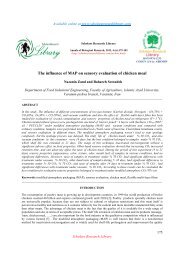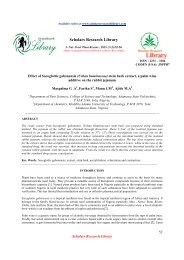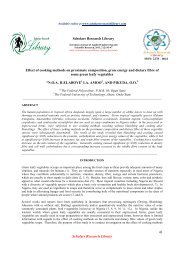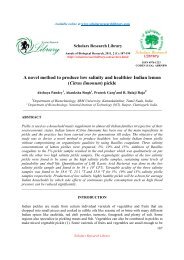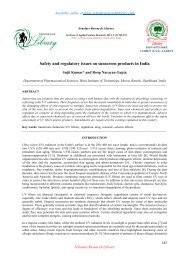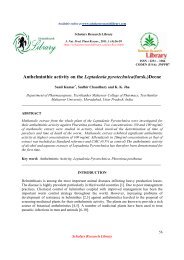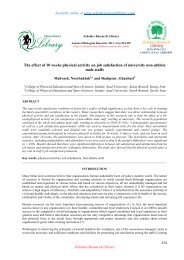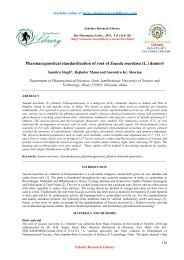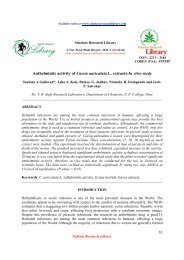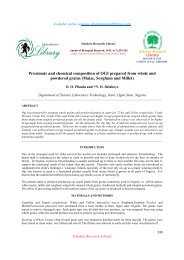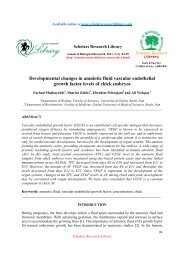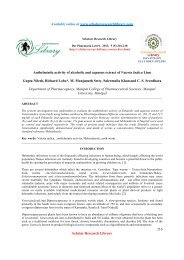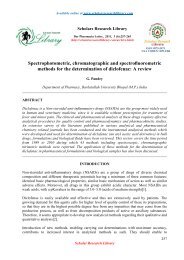Phytochemical analysis, in-vitro screening for antimicrobial and ...
Phytochemical analysis, in-vitro screening for antimicrobial and ...
Phytochemical analysis, in-vitro screening for antimicrobial and ...
You also want an ePaper? Increase the reach of your titles
YUMPU automatically turns print PDFs into web optimized ePapers that Google loves.
G. V. Pavan Kumar et al Der Pharmacia Lettre, 2013, 5 (1):168-176<br />
_____________________________________________________________________________<br />
<strong>and</strong> laxative <strong>and</strong> is used <strong>for</strong> treatment of dysmenorrhea, eczema, emmenagogue, galactagogue, gout, jaundice,<br />
kidney (stone), leprosy, leucorrhea, piles, pneumonia, psoriasis, rheumatism <strong>and</strong> scabies It conta<strong>in</strong>s biologically<br />
active chemicals that <strong>in</strong>clude glycosides, sapon<strong>in</strong>s, alkaloids, fixed oils, triterpenes, prote<strong>in</strong>s <strong>and</strong> steroids [7]. The<br />
immature fruits are a good source of Vitam<strong>in</strong> C <strong>and</strong> also provide Vitam<strong>in</strong> A, phosphorus, <strong>and</strong> iron .Several<br />
phytochemicals such as momordenol, momordicil<strong>in</strong>, momordic<strong>in</strong>s, momordic<strong>in</strong><strong>in</strong>, momord<strong>in</strong>, momordolol,<br />
cryptoxanth<strong>in</strong>, cucurbit<strong>in</strong>s, cucurbitac<strong>in</strong>s, cucurbitanes, cycloartenols, diosgen<strong>in</strong>, elaeostearic acids, erythrodiol,<br />
galacturonic acids, gentisic acid, goyaglycosides, goyasapon<strong>in</strong>s, multiflorenol, have been isolated [8].These are<br />
reported <strong>in</strong> all parts of the plant.The hypoglycemic chemicals of plant are a mixture of steroidal sapon<strong>in</strong>s known as<br />
charant<strong>in</strong>s, <strong>in</strong>sul<strong>in</strong>-like peptides <strong>and</strong> alkaloids <strong>and</strong> these chemicals are concentrated <strong>in</strong> fruits , there<strong>for</strong>e fruit has<br />
shown more pronounced hypoglycemic/antihyperglycemic activity. However, two types of hypoglycemic<br />
substances have been differentiated with different time dependent effects—one with fast antihyperglycemic activity<br />
of around 1 h present <strong>in</strong> the aqueous <strong>and</strong> the residue after alkal<strong>in</strong>e chloro<strong>for</strong>m extraction of aqueous extract <strong>and</strong><br />
another with a slow hypoglycemic activity <strong>in</strong> acidic wash of the chloro<strong>for</strong>m extract rema<strong>in</strong><strong>in</strong>g after an alkal<strong>in</strong>e water<br />
wash. HIV <strong>in</strong>hibitory prote<strong>in</strong>s like MRK29 (MW: 28.6 kDa), ssssssMAP30 (MW: 30,000 kDa) <strong>and</strong> lect<strong>in</strong> are<br />
documented [9].The presence of tryps<strong>in</strong> <strong>in</strong>hibitors, elastase <strong>in</strong>hibitors , guanylate cyclase <strong>in</strong>hibitors <strong>and</strong> alphaglucosidase<br />
<strong>in</strong>hibitor like D-(+)-trehalose are also reported [10].<br />
MATERIALS AND METHODS<br />
Plant material<br />
Fresh seeds of plants Cori<strong>and</strong>rum sativum,Cassia occidentalis,Carica papaya,Mor<strong>in</strong>ga foetida were collected from<br />
Asw<strong>in</strong>i Herbal Garden, H<strong>in</strong>du College of pharmacy, Guntur , Andhra Pradesh (A.P), India. Seeds were washed<br />
thoroughly with distilled water <strong>and</strong> then shade dried. All the dried seeds were wholly powdered with the help of<br />
mixer gr<strong>in</strong>der <strong>and</strong> further used <strong>for</strong><br />
extract preparation.<br />
2.1 Prelim<strong>in</strong>ary <strong>Phytochemical</strong> Screen<strong>in</strong>g<br />
The extracts were subjected to prelim<strong>in</strong>ary phytochemical test<strong>in</strong>g to detect <strong>for</strong> the presence of different chemical<br />
groups of compounds. Air-dried <strong>and</strong> powdered Seed materials were screened <strong>for</strong> the presence of tann<strong>in</strong>s, alkaloids,<br />
flavonoids, triterpenoids, steroids, prote<strong>in</strong>s, Am<strong>in</strong>oacids <strong>and</strong> glycosides [11-13].<br />
2.2 Preparation of Plant Extract<br />
Extraction<br />
The extraction of the seeds of four prom<strong>in</strong>ent plants was carried out us<strong>in</strong>g known st<strong>and</strong>ard procedures[14]. The<br />
seeds were dried <strong>in</strong> shade <strong>and</strong> powdered <strong>in</strong> a mixer gr<strong>in</strong>der. The powder (25.0 g) of the seeds were <strong>in</strong>itially defatted<br />
with petroleum ether (60-80°C), followed by 900 ml of hydroalcohol (30:70) by us<strong>in</strong>g a Soxhlet extractor <strong>for</strong> 72<br />
hours at a temperature not exceed<strong>in</strong>g the boil<strong>in</strong>g po<strong>in</strong>t of the solvent. The extracts were filtered us<strong>in</strong>g Whatman filter<br />
paper (No.1) while hot, concentrated <strong>in</strong> vacuum under reduced pressure us<strong>in</strong>g Rotary flask evaporator, <strong>and</strong> dried <strong>in</strong> a<br />
desiccator. The hydroalcoholic extract yields a dark brown solid residue weigh<strong>in</strong>g 5.750 g (23.0% w/w). More<br />
yields of extracts were collected by this method of extractions. The dry weight of the Seeds extract was obta<strong>in</strong>ed by<br />
the solvent evaporation <strong>and</strong> used to determ<strong>in</strong>e concentration <strong>in</strong> mg/ml. The extract was then kept <strong>in</strong> sterile bottles,<br />
preserved at 2- to 4°C under Refregirated conditions until further use . This crude hydroalcoholic extract was then<br />
used to <strong>in</strong>vestigate further <strong>for</strong> potentials of Antimicrobial <strong>and</strong> Anthelm<strong>in</strong>tic properties.<br />
3. Antimicrobial screen<strong>in</strong>g<br />
Test Microorganisms <strong>and</strong> Growth Media<br />
The follow<strong>in</strong>g microorganisms Staphylococcus aureus (MTCC 96), Streptococcus pyogenes (MTCC 442),<br />
Escherichia coli (MTCC 443), Pseudomonas aerug<strong>in</strong>osa (MTCC 424) <strong>and</strong> fungal stra<strong>in</strong>s Aspergillus niger (MTCC<br />
282), Aspergillus clavatus (MTCC 1323), C<strong>and</strong>ida albicans (MTCC 227) were chosen based on their cl<strong>in</strong>ical <strong>and</strong><br />
pharmacological importance[15-19].The bacterial stra<strong>in</strong>s obta<strong>in</strong>ed from Institute of Microbial Technology,<br />
Ch<strong>and</strong>igarh, were used <strong>for</strong> evaluat<strong>in</strong>g <strong>antimicrobial</strong> activity. The bacterial <strong>and</strong> fungal stock cultures were <strong>in</strong>cubated<br />
<strong>for</strong> 24 hours at 37°C on nutrient agar <strong>and</strong> potato dextrose agar (PDA) medium, respectively, follow<strong>in</strong>g refrigeration<br />
storage at 4°C. The bacterial stra<strong>in</strong>s were grown <strong>in</strong> Mueller-H<strong>in</strong>ton agar (MHA) plates at 37°C (the bacteria were<br />
grown <strong>in</strong> the nutrient broth at 37°C <strong>and</strong> ma<strong>in</strong>ta<strong>in</strong>ed on nutrient agar slants at 4°C), whereas the yeasts <strong>and</strong> molds<br />
were grown <strong>in</strong> Sabouraud dextrose agar <strong>and</strong> PDA media, respectively, at 28°C. The stock cultures were ma<strong>in</strong>ta<strong>in</strong>ed<br />
at 4°C.<br />
Scholar Research Library<br />
170



